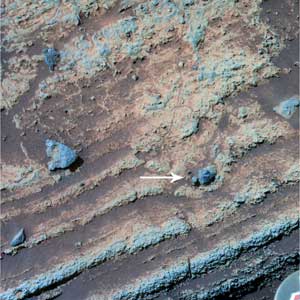|
NEWS NOTES — NEWS
Planetary geology
Mars had explosive, watery past
 NASA/JPL-Caltech/USGS/Cornell |
| During its more than one-year-long exploration of Home Plate, a plateau of layered rock on Mars, NASA rover Spirit rolled by a rock that appears to have been launched into the air during a past volcanic episode. |
NASA’s Mars rover Spirit hit a grand slam this spring when it rolled across Home Plate, a plateau feature on Mars that revealed clues supporting an explosive past for the planet.
When a rock is explosively launched into the air and then falls back down, it depresses the ground on which it lands, creating a “bomb sag.” Such sags are a major piece of evidence of past explosive volcanism on Earth. Now, images from Spirit show a similar feature on Mars, which Steven Squyres of Cornell University in Ithaca, N.Y., and colleagues described May 4 in Science. Evidence that explosive volcanism existed on Mars further supports suggestions that the planet had a watery past, the team reported.
Spirit roved by the bomb sag formation during its mission in Gusev crater to explore Home Plate plateau, a main feature of interest in the crater. It measures at least 2 meters (more than 6 feet) tall and spans 90 meters (almost 300 feet) — about the same distance from home plate to the right field fence in the average major league ballpark. The panoramic camera onboard Spirit allowed the team to photograph the bomb sag, which measures 4 centimeters (1.6 inches) across, and appears to deform the material beneath it, suggesting explosive volcanism.
But volcanism is not the only possible explanation for the feature. “It is also conceivable that the bomb is a piece of ejecta thrown out from a meteorite impact,” says Sarah Fagents, a planetary volcanologist at the University of Hawaii at Honolulu. Other evidence on Home Plate, however, including the geochemistry, layered strata and small, round granules that resemble features seen on Earth that form under volcanic conditions, “suggests that an explosive volcanic origin is a more likely explanation,” she says.
If explosive volcanism indeed occurred on Mars, it could have been triggered when magma moving underground encountered water, Squyres and colleagues wrote. And while water is not required to drive the explosion, Fagents says, other watery indicators also exist, including the ground under the bomb sag, which appears to have been soft and possibly wet when it was depressed.

 Subscribe
Subscribe


